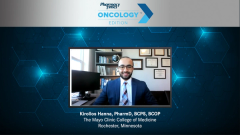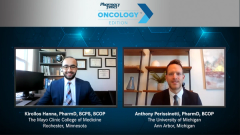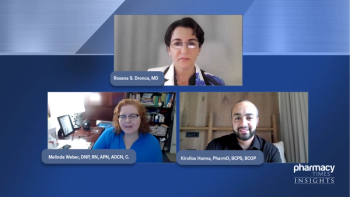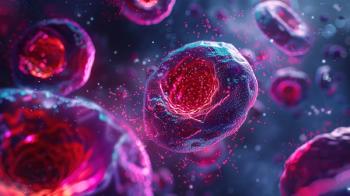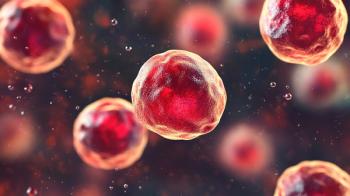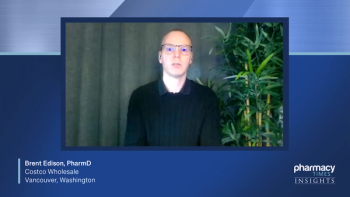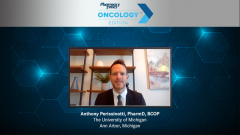
CAR T for Chronic Lymphocytic Leukemia
Experts discuss the potential future use of CAR T-cell therapy and bispecific therapeutics for chronic lymphocytic leukemia based on data presented at ASH 2021.
Episodes in this series

Kirollos Hanna, PharmD, BCPS, BCOP:Another exciting thing that we saw at ASH [American Society of Hematology 2021 Annual Meeting], CAR [chimeric antigen receptor] T in CLL [chronic lymphocytic leukemia]. Dr Perissinotti, what do you know about CAR-T cells?
Anthony Perissinotti, PharmD, BCOP: With CAR T, it has taken some time in CLL to come to fruition, mainly because we’ve had so many other good, effective therapies. And CAR T is expensive. It’s laborious. And there’s quite a bit of logistics for patients and toxicities. There were 2 abstracts at ASH that clinically aren’t going to change things but, at least scientifically, I think are really important. One was by Shadman [Mazyar Shadman, MD, MPH, Fred Hutchinson Cancer Research Center, University of Washington, Seattle, WA] and colleagues. They were trying to show some responses in a third-generation CAR T. The first generations didn’t have a costimulatory domain. And then in second gens [generations], we added either 4-1BB or CD28. Third gens [generations] have 2 costimulatory domains, which had 4-1BB and CD28. The idea there is better T cell activation and more persistence. There was only 1 patient with CLL in this study and that patient had a CR [complete response]. Again, it’s the science aspect of this that I think is going to be the most interesting. The second CAR T study was of AUTO1. This was by Roddie [Claire Roddie, PhD, MD University of London, London, United Kingdom] and colleagues, presented at ASH. Again, a scientific breakthrough, I think, as opposed to a clinical right now. Only 1 patient with CLL was studied in this trial. The claim to fame with AUTO1 is that it has a fast dissociation with CD19, and so it binds to CD19 very quickly but then comes off a little bit quicker than our previous CAR T cells. And the idea is that, perhaps, we’ll have less cytokine release syndrome [CRS] and less neurotoxicity. In fact, in these small numbers, we saw no neurotoxicity, and there were no cases of grade 3 or higher CRS that they reported. I think something to just keep an eye on with CAR T and CLL, but at this point, I didn’t see anything at ASH that is going to lead to something in clinical practice in the next year or so.
Kirollos Hanna, PharmD, BCPS, BCOP: I think that leads me into another exciting or up-and-coming pharmacological class: our bispecific drugs. I think epcoritamab. Looking at the epcor [epcoritamab] trial, from what was published at ASH, this is really looking at again, bispecific antibodies. This is nothing new in oncology care. But it’s, again, something new, definitely, to the CLL patient population. Looking at this bispecific therapeutic, it’s really looking at potent activation and cytotoxic activity through CD4 positivity and CD8-positive cells, so really trying to incorporate that into that CLL patient population. The clinical trial that was presented was by Kater [Arnon P. Kater, MD, PhD, of Cancer Center Amsterdam, Netherlands] and colleagues, was a phase 1B2 trial trying to evaluate dose-limiting toxicities and early, early signs of clinical efficacy of epcoritamab in the relapsed/refractory CLL patient population. The eligible patients, or the patients that they looked at, had to receive at least 2 or more lines of therapy for CLL, so that could’ve been BTK [Bruton tyrosine kinase], BCL2 [B-cell lymphoma 2], etc. Ultimately, they had 2 types of dosing schemas. One was at 24 milligrams and 1 was at 48 milligrams. And what the data suggested is that those levels up to that 48-milligram had good clinical activity in patients with high-risk features and were well tolerated. Now, notable things that they did observe in this clinical trial; cytokine release syndrome happened in almost all the patients that were observed. Again, it was a small subset of patients in this clinical trial. They did see some fatigue, injection site reactions, and nausea. But all that CRS that did occur was predominantly during the first cycle, and there were really no CRS events that were deemed to be higher than a grade 2, so generally well-managed. But also, as Dr Perissinotti said, these therapeutics, CAR T, bispecific therapeutics, our noncovalent BTK inhibitors, and even our newer PI3K [phosphoinositide 3-kinase] inhibitors, all these things are in the pipeline, but we’re starting to evaluate these in terms of, could we use these next? From what we saw at ASH, none of these therapeutics are yet in line to replace that standard of care frontline therapy that we mentioned, or even in that second-line setting, from the efficacy data that we highlighted here today.
Transcript edited for clarity.
Newsletter
Stay informed on drug updates, treatment guidelines, and pharmacy practice trends—subscribe to Pharmacy Times for weekly clinical insights.

